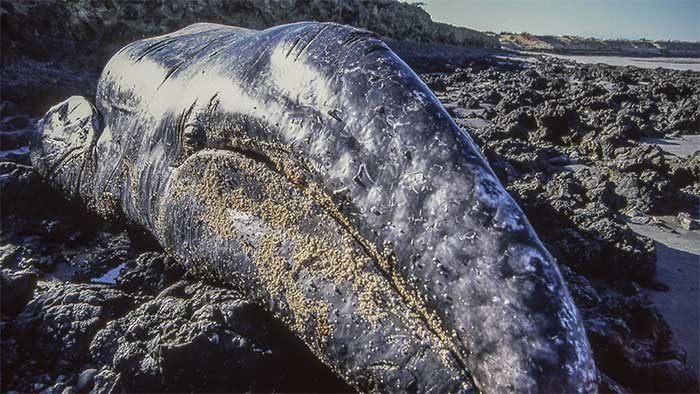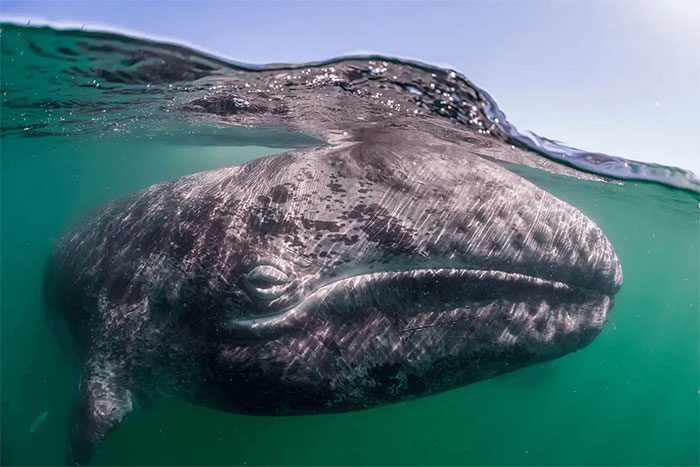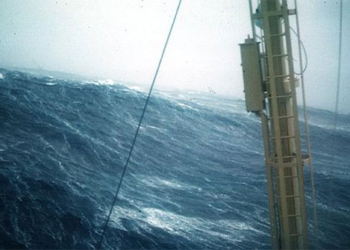The gray whale population is alarmingly declining worldwide.
Unusual Deaths…
The stranding of thousands of gray whales (Eschrichtius robustus) from the coast of Mexico to Alaska (USA) since the 1980s has been declared by NOAA as an “unusual mass mortality event” that remains unexplained.
For the past four decades, researchers have only been able to speculate on what has caused these whales to die, with no formal studies identifying the reasons behind the mysterious deaths of this gigantic species.

Gray whales were hunted to the brink of extinction. (Photo: CampPhoto via Getty Images).
Even more concerning, scientists are puzzled by the rising number of dead gray whales washing ashore.
According to scientists, there have been three mass mortality events affecting gray whales off the coast of North America since the 1980s, leading to population declines of 15% to 25% each time. In total, over 2,000 gray whales are known to have died.
The first mass mortality event occurred from 1987 to 1989 and was the largest, resulting in the deaths of at least 700 whales.
The second event occurred between 1999 and 2000, killing 651 gray whales.
The most recent mass mortality event began in 2019 and saw over 70 gray whales die within just six months. As of September 26, 2023, a total of 688 gray whales have died. The cause of each event remains unclear.
According to statements, commercial whaling (for ambergris, oil, etc.) until the mid-20th century nearly led the North Pacific gray whale population to extinction, but it has since recovered to about 14,500 individuals.
A new study published in mid-October 2023 in the journal Science suggests that changing conditions and sea level fluctuations in the Arctic may provide a clearer explanation for what the National Oceanic and Atmospheric Administration (NOAA) refers to as an “unusual mass mortality event.”
Decoding the Mystery
Recently, a team of scientists at the Marine Mammal Institute at Oregon State University has stated they have compelling evidence that the deaths of gray whales are directly related to melting ice in the Arctic.
Dr. Joshua Stewart, a researcher at the Marine Mammal Institute and the lead author of the study, noted that the reduction of sea ice also diminishes the food supply for gray whales.
Specifically, the historic loss of ice in the Arctic Ocean may be the cause of the recent gray whale deaths.
This is because sea ice hosts a rich layer of algae on its underside, which decomposes and releases food to the seafloor for bottom-dwelling organisms, including the gray whale’s preferred crustaceans.

Gray whales migrate over 19,312 km each year. (Photo: National Geographic)
Gray whales undertake the longest migration of any mammal on Earth, traveling over 19,312 km each year from their feeding grounds in the Arctic—where they spend each summer—to breeding areas in the warm, shallow lagoons of the Baja Peninsula in Mexico, where they winter.
While in the Arctic, gray whales feed on amphipod crustaceans. In turn, these calorie-rich crustaceans consume algae, which grows on the underside of sea ice.
“When there is less ice, there will be less algae, which becomes a ‘disaster’ for the prey of gray whales. When the quality of prey drops suddenly, the gray whale population will significantly decline.”
In other words, melting sea ice disrupts the entire food chain of gray whales. Additionally, warmer waters promote the presence of smaller deep-sea crustaceans and faster currents, reducing the habitat for the gray whale’s preferred prey, according to information from Independent.
Overall, the reduced availability of food may cause whales to become thinner or malnourished, as well as lead to lower birth rates.
Dr. Joshua Stewart stated that while the food chain is affected, he does not believe gray whales are currently at risk of extinction.
Decades ago, gray whales were hunted to the brink of extinction. However, thanks to the implementation of international whaling regulations, the population of these animals has rebounded.
The lead author of the study warns that the decline in whale numbers during the era of global warming serves as a reminder of the widespread impacts of the climate crisis, as sea ice continues to melt at alarming and historic rates.
“Even highly mobile, long-lived species like gray whales are very sensitive to the impacts of climate change. If we do not address this issue, we will have to get used to having fewer gray whales.”





















































